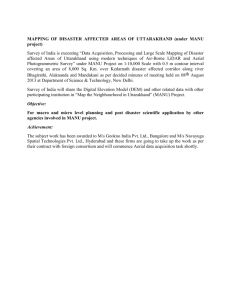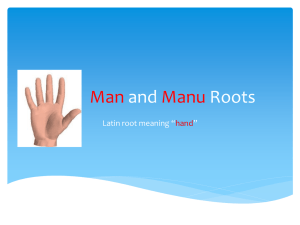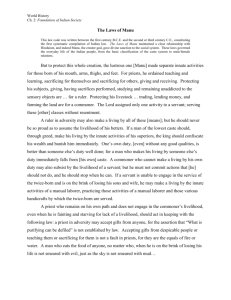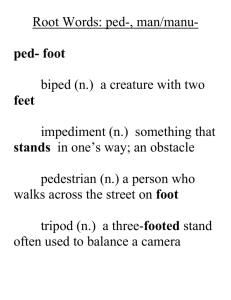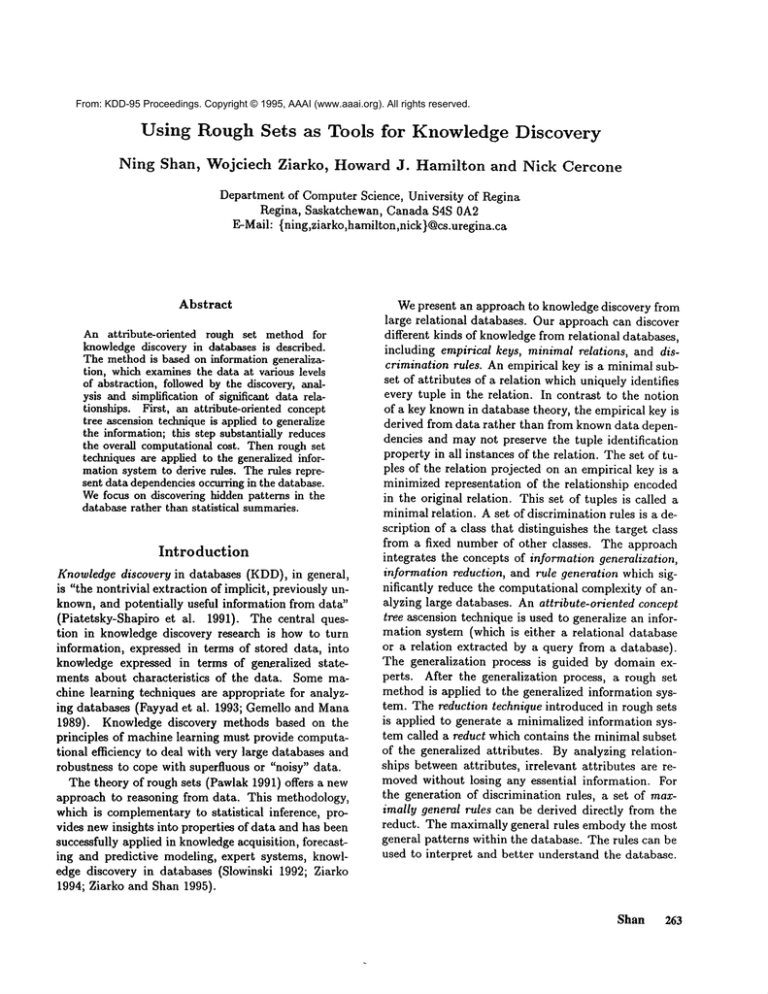
From: KDD-95 Proceedings. Copyright © 1995, AAAI (www.aaai.org). All rights reserved.
Using Rough Sets as Tools for Knowledge Discovery
Ning
Shan,
Wojciech
Ziarko,
Howard
J.
Hamilton
and
Nick
Cercone
Department of Computer Science, University of Regina
Regina, Saskatchewan, Canada $4S 0A2
E-Mail: {ning,ziarko,hamilton,nick }@cs.uregina.ca
Abstract
An attribute-oriented
rough set method for
knowledgediscovery in databases is described.
The methodis based on information generalization, whichexaminesthe data at various levels
of abstraction, followed by the discovery, analysis and simplification of significant data relationships. First, an attribute-oriented concept
tree ascensiontechniqueis applied to generalize
the information; this step substantially reduces
the overall computational cost. Then rough set
techniques are applied to the generalized informationsystem to derive rules. The rules represent data dependenciesoccurring in the database.
Wefocus on discovering hidden patterns in the
database rather than statistical summaries.
Introduction
Knowledge discovery in databases (KDD), in general,
is "the nontrivial extraction of implicit, previously unknown, and potentially useful information from data"
(Piatetsky-Shapiro et al. 1991). The central question in knowledge discovery research is how to turn
information, expressed in terms of stored data, into
knowledge expressed in terms of generalized statements about characteristics
of the data. Somemachine learning techniques are appropriate for analyzing databases (Fayyad et al. 1993; Gemello and Mana
1989). Knowledge discovery methods based on the
principles of machine learning must provide computational efficiency to deal with very large databases and
robustness to cope with superfluous or "noisy" data.
The theory of rough sets (Pawlak 1991) offers a new
approach to reasoning from data. This methodology,
which is complementaryto statistical
inference, provides new insights into properties of data and has been
successfully applied in knowledgeacquisition, forecasting and predictive modeling, expert systems, knowledge discovery in databases (Slowinski 1992; Ziarko
1994; Ziarko and Shan 1995).
Wepresent an approach to knowledge discovery from
large relational databases. Our approach can discover
different kinds of knowledgefrom relational databases,
including empirical keys, minimal relations, and discrimination rules. An empirical key is a minimal subset of attributes of a relation which uniquely identifies
every tuple in the relation. In contrast to the notion
of a key knownin database theory, the empirical key is
derived from data rather than from knowndata dependencies and maynot preserve the tuple identification
property in all instances of the relation. The set of tuples of the relation projected on an empirical key is a
minimized representation of the relationship encoded
in the original relation. This set of tuples is called a
minimal relation. A set of discrimination rules is a description of a class that distinguishes the target class
from a fixed number of other classes. The approach
integrates the concepts of information generalization,
information reduction, and rule generation which significantly reduce the computational complexity of analyzing large databases. An attribute-oriented concept
tree ascension technique is used to generalize an information system (which is either a relational database
or a relation extracted by a query from a database).
The generalization process is guided by domain experts. After the generalization process, a rough set
methodis applied to the generalized information system. The reduction technique introduced in rough sets
is applied to generate a minimalized information system called a reduct which contains the minimal subset
of the generalized attributes. By analyzing relationships between attributes, irrelevant attributes are removed without losing any essential information. For
the generation of discrimination rules, a set of maximally general rules can be derived directly from the
reduct. The maximally general rules embodythe most
general patterns within the database. The rules can be
used to interpret and better understand the database.
Shan
263
Make-Model
Ford Escort
Dodge Shadow
Ford Festive
Chevrolrt Corvette
Dodge Stealth
Ford Probe
Ford Mustang
Dodge Daytona
Chrysler Le Baron
Dodge Sprite
Honda Civic
Ford Escort
Ford Tempo
Toyota Corolla
Mazda 323
Dodge Daytona
Honda Prelude
Toyota Paseo
Chevrolet Corsiez
Chevrolet Beretta
Chevrolet Cavalier
ChryIler Le Baron
Mazda 626
Chervolet Corsica
Chevrolet
Lumina
Fuel
EFI
EFI
EF!
EFI
EFI
BFI
EF[
EFI
EFI
EFI
2-BBL
2-BBL
2.BBL
EFI
EFI
EFI
EFI
2-BBL
EFI
BFI
EFI
BFI
EF!
EFI
EFI
Di.p
Medium
Medium
Medium
Medium
Medium
Medium
Medium
Medium
Medium
Medium
Small
Small
Small
Small
Medium
Medium
Small
Small
Medium
Medium
Medium
Medium
Small
Small
Small
Weight
876
1100
1589
087
1096
867
1197
708
1056
1657
786
1098
1187
1023
698
1123
1094
1023
980
1600
1002
1008
1039
980
1000
C~l
6
6
6
6
6
6
6
6
4
5
4
4
4
4
4
4
4
4
4
5
6
4
4
4
4
Power
High
High
High
High
High
High
High
High
Medium
High
Low
Low
Medium
Low
Medium
Medium
High
Low
High
High
High
High
Medium
Medium
Medium
Turbo
yes
no
no
11o
no
no
no
yes
no
rlo
I~o
no
no
no
no
no
yes
no
yes
flo
no
no
no
no
no
Comp
high
medium
high
medium
high
medium
high
high
medium
medium
high
high
high
high
medium
medium
high
medium
medium
medium
medium
medium
high
high
high
Tr&n
auto
menu
menu
menu
menu
mznu
menu
menu
menu
menu
m&uu
manu
auto
m&nu
menu
mznu
manu
m&nu
menu
auto
aUtO
aUtO
manu
m&nu
manu
Milea~;e
medium
medium
medium
medium
medium
medium
medium
high
medium
low
high
medium
medium
high
high
medium
high
high
medium
low
medium
medium
high
high
high
Table 1: A collection of car information.
Information
Generalization
{Honda_Civic,
...,
Honda.Accord}
C Honda
Formally, an information system S is a quadruple
{Toyot el.Tercel,
...,
Toyota_Camry}
C Toyota
{Mazda**323, Mazda.626, ...
Mazda.939}
C Mazda
< U, A, V, f >, where U : {Xl,Z2,...,Xn}
is a
{Honda, Toyota,...,
Mazda}
C Japan(Car)
nonempty
finite set of objects, A is a finite set of at{Ford-E,cort,
Ford.Probe,...,
Ford_Taurus}
C Ford
tributes, V = [.JvEAVpis a nonempty
finite set of val{Chevrolet _Corvette, ...,
Chervolet.Corsica}
C Chevrolet
ues of attributes whereVpis the domainof attribute p
{Dodge.Stealth,
...,
Dodge_Dynasty}
C Dodge
(the set of values of attribute p), andf : U × A --~ V
{Ford, Dodge, ...,
Chevrolet)
C USA(Car)
{Japan(Car),
...,
USA(Car)}
an information function which assigns particular valC Any(Make.Model)
{o..8oo}
C Light
ues fromthe domainsof attributes in A to objects such
{801.,1200}
C Medium
that f(xi,p) E Vv for allxi E U andpE A. In are(1201..1600}
C Heavy
lational database system, the function f assigns each
{Light,
Medium, Heavy}
C Any(Weight)
object to a unique tuple of a database table to avoid
duplication and to provide storage efficiency. Weview
Figure 1: Examplesof concept hierarchies for Table 1.
a relational database table as an information system
In our opinion, the procedureof information generand use the terms relational database table and inalization should be guided by domainexperts, because
formation system interchangeably. Table 1 shows an
deep understandingof the meaningof the higher level
information system for a collection of Japanese and
concepts is required. By identifying relevant attributes
Americancars.
andguiding the generalization to a certain level in the
A concept hierarchy for an attribute Ai is repreconcept hierarchy, the domain expert can obtain an
sented as an attribute value classification tree, called
appropriate generalized information system.
a concept tree. A higher-level value is a moregeneral
value correspondingto the set of values of lower-level
Anattribute is generalizable if there exists a convalues in the concept tree. Typically, concept hierarcept hierarchy for the attribute. Otherwise, it is nonchies for a database are provided by knowledgeengigeneralizable. If an attribute is generalizable, it can
neers or domainexperts, but some hierarchies can be
be generalized to a higher level by concepttree ascenconstructed automatically (Michalski 1983). Figure
sion, which correspondsto the climbing generalization
shows concept hierarchies for the "Make_Model"
and
trees generalization rule (Cai et al. 1991). If an at"Weight"attributes of Table 1.
tribute is nongeneralizable, it can be removed,which
A large database usually contains manydistinct atcorresponds to the dropping conditions generalization
tribute values and is too refined for a clear representarule (Michalski 1983). This removal can be viewed
as a generalization to the most general concept ANY.
tion of knowledge. For the purpose of knowledgediscoveryit is often useful to replace the original attribute
The replacement of the value in a tuple by a higher
values of an information system with moregeneral catlevel concept generalizes the tuple by makingit cover
egories, such as value ranges andhigher level concepts.
morecases than the original one. The final generalized
Thus, patterns not visible within the original database
information system may consist of only a small nummaybecomevisible.
ber of distinct tuples. Table 2 showsthe result of the
264
KDD-95
Make..Model
USA
USA
USA
USA
USA
USA
USA
Jspan
USA
USA
Japan
Japan
Japan
Japan
USA
USA
USA
USA
Japan
USA
Fuel
EFI
EFI
EFI
EFI
BFI
EFI
EFI
2-BBL
2-BBL
2-BBL
EFI
EFI
EFI
2-BBL
EFI
EFI
EFI
BFI
EFI
EFI
Disp
Medium
Medium
Medium
Medium
Medium
Medium
Medium
Small
Small
Small
Small
Medium
Small
Small
Medium
Medium
Medium
Medium
Small
Small
Wei~[ht
Medium
Medium
Heavy
Medium
Light
Medium
Heavy
Light
Medium
Medium
Medium
Light
Medium
Medium
Medium
Heavy
Medium
Medium
Medium
Medium
Cyl
6
6
6
6
6
4
6
4
4
4
4
4
4
4
4
6
6
4
4
4
Power
High
High
High
High
High
Medium
High
Low
Low
Medium
Low
Medium
High
Low
High
High
High
High
Medium
Medium
Turbo
yes
no
no
no
yes
no
no
no
no
no
no
no
yes
no
yes
no
no
no
no
no
Comp
high
medium
high
high
high
medium
medium
high
high
high
high
medium
high
medium
medium
medium
medium
medium
high
high
Tran
auto
manu
manu
manu
manu
manu
manu
manu
manu
auto
manu
manu
manu
manu
mauu
aUtO
auto
auto
m&~u
manu
Mileage
medium
medium
medium
medium
high
medium
low
high
medium
medium
high
high
high
high
medium
low
medium
medium
high
high
CNo
1
3
1
2
1
2
1
1
1
1
1
1
1
1
1
1
1
1
1
2
Table 2: A generalized car information system.
generalized car information system created by generalizing the attributes "Make_Model"
and "Weight"to
a higher level. The levels of the other attributes are
already considered appropriate. The numeric column
"CNo"is the numberof tuples in the original database
whichsupport the generalized tuple. It provides a measure of strength or confidence associated with the tupie (Ziarko 1991). generalized in formation sy stem
maintains the relationship amonggeneralized data in
different attributes for a frequently querieddata set.
The following simple algorithm extracts a generalized information system from a relation R. Moresophisticated algorithms are given in (Han 1994) and
(Carter and Hamilton 1995).
Generalization Algorithm:Extracts a generalized
informationsystemfroma relation.
Input: (i) A set of task-relevantdata R, a relation
of arity n witha set of attributes Ai ( 1 < i < n);
(ii) a set Hof concepthierarchies,whereeach
H/EHis a hierarchyon the generalized
attributeAi, if available;
(iii) li is the specifiedlevel for attributeAi;
Output:The generalized information system R’
R’ ¢-- R
for i = 1 to n do
if Ai is not generalizablethen
Removeattribute Ai from R’
else
if level is not appropriatethen
Ascendtree Hi to the specified level li
andmakeappropriatesubstitutions in R’
endif
endif
endfor
Removeduplicates from R’
Supposethere are n tuples in a database table with
a attributes. The time for substituting the lower level
concepts by the higher level concepts is an for all attributes and the time for deleting redundanttuples is
n log n. Thus, the total time is at most(an + n log n).
Since a are muchsmaller than n in a large database,
the time complexity of the attribute-oriented method
is O(nlog n).
Discovery
of Empirical
Keys, Minimal
Relations,
and Core Attributes
Suppose we wish to discover minimal relations characterizing Japanesecars using subset of attributes in
the car information system. This discovery task can be
represented as an SQL-like request (Cai et al. 1991)
that includes the attribute "Make_Model=Japan".
The result of the query is the relation shownin Table 3.
The tuples in a generalized information system represent a certain relationship betweenattributes of the
objects (cars). Every relationship amongattributes
correspondsto a classification of objects of an information system into disjoint equivalence classes whereobjects belonging to the same equivalence class have the
same attribute values. The classification corresponding to the set of attributes A can be represented by
an equivalence relation R(A) C_ OBJ x OBJ. Two
relationships, one between attributes Q and the other
between attributes P, of an information system are
equivalent if they producethe same classification of
OBJ, that is if R(P) = R(Q).
Based on the above observations, one can see that
the same relationship maybe described in a simpler
wayby using the technique of attribute reducts (Pawlak
1991), resulting in a simpler information representation and better understandingof the nature of the relationship. A reduct is a minimalsufficient subset of
attributes REDC_ A such that
(a) R(RED) = R(A), i.e., REDproduces the same
classification of objects as the wholeattribute collection A, and
(b) for any a E RED, R(RED- {a}) ~ R(A), that
is, a reduct is a minimal subset with respect to the
property(a).
By definition, each reduct represents an alternative and simplified way. of expressing the same relationship between attributes. It is easy to see that
Shan
265
Fue|
2-BBL
EFI
EFI
EFI
2-BBL
EFI
Disp
Small
Small
Medium
Small
Small
Small
Weight
Light
Medium
Light
Medium
Medium
Medium
Cyl
4
4
4
4
4
4
Power
Low
Low
Medium
High
Low
Medium
Turbo
no
no
no
yes
no
no
Comp
high
high
medium
high
medium
high
Tran
manu
manu
manu
manu
manu
manu
Milea~;e
high
high
high
high
high
high
CNo
1
1
1
1
1
I
Table 3: A generalized car information system.
reduct has the same properties as key defined in relational database theory (with respect to a specific
instance of a relation only), and therefore it can be
called an empirical key in this context. For example, in the generalized information system given in Table 3 one can identify the following reducts (empirical keys): {Fuel, Weight, Power}, {Fuel, Power, Comp}
and {Weight, Power, Comp}. The projections of Table 3 on above empirical keys result in three different
minimal relations.
The core attributes are the ones which cannot be
eliminated from A without affecting our ability to classify an object into a particular relationship category.
They are the most significant attributes in the analyzed relationship. The core attribute set is equal to
the intersection of all computedreducts (Pawlak 1991).
For example, the core attribute set of the generalized
information system given in Table 3 is "Power" which
meansthat it is the fundamental factor in the relationship between the given attributes. In other words, the
relationship class of an object cannot be determined
without knowing "Power" attribute values.
Discovery
of Discrimination
Rules
In this section, a method for discovering discrimination rules using rough set theory is introduced. Suppose our objective is to discover a set of decision
rules which identify the features of a car that determine the "Mileage". The discovery task extracts
the relevant set of data shown in Table 2 from the
car’s database. In such an information table, attributes A can be partitioned into two (disjoint) subsets, the condition attributes C and decision attributes
D. Let R*(C) = {XI,X2,...,Xn}
be the collection
of equivalence classes of the relation R(C), and let
R*(D) = {Y1, Y~, ..., Y,,} be the collection of equivalence classes of the relation R(D), where each element
Y/ is a group of objects having the same values for
all attributes in D and creates a concept on the universe U. The pair AS = (U,R(C)) is called an approximation space (Pawlak 1991). The lower approximation in the approximation space AS, denoted as
LOW(C,D), is defined as the union of those equivalence classes in R* (C) which are completely contained
by one of the equivalence classes Y/ G R*(D), that is
LOW(C, D) = (_Jy, em(D){Z R*(C) : X C_Y~}. The
degree of dependency If(C, D) in the relationship be266 KDD--95
tween the groups of attributes C and D can be defined
as If(C,D) ca,d(LOW(C,O))
card(U) , where card yields set
cardinality. The dependency between two sets of attributes C and D indicates the extent to which values of attributes in D depend on the values of attributes in C. By definition,
0 < K(C,D) < 1 because LOW(C,D)C U. If K(C,D) is equal to 1, the
dependency, as represented in the information system
table, is fully functional. K(C, D) is equal to 0 when
none of the values of attributes in D can be uniquely
determined from the values of attributes in C.
Attribute
Reduction
A relative reduct (Pawlak 1991) is a minimalsufficient
subset of a set of attributes whichpreserves the degree
of dependency with respect to another set and which
has the same ability to discern concepts as when the
full set of attributes is used.
Definition A subset B of a set of attributes C is a
relative reduct of C with respect to a set of attributes
D if: 1) If(B,D) = If(C, O), and If(B, D) ¢ K(B
{a}, D), for any a C B.
The first condition ensures that a relative reduct preserves the degree of dependencywith respect to D, and
the second condition ensures that a relative reduct is a
minimal subset and that any further removal of condition attributes will change the degree of dependency.
The following algorithm constructs a relative reduct
for an information system.
Generalization Algorithm: Computesa relative reduct
Input: (i) A generalized information system
¯ (ii) Aset of attributes C over
(iii) The degree of dependency/((C, D)
Output: A relative reduct SM
Computethe significance value for each attribute a E C
Sort the set of attributes C in ascendingorder
of the significancevalues
SMe-C
N .-ISMI
fori=0toN-1
do
Removethe i th attribute a, from the set SM
if f((SM, D) ~ If(C, D) then
SM (--SMUa~
endif
endfor
First, the algorithm assigns a significance value based
on an evaluation function to each attribute and sorts
the attributes based on their significance values. To
compute a reduct, the algorithm remove attributes one
Make-Model
USA
USA
USA
USA
USA
USA
USA
Japan
USA
USA
Japan
Japan
Japan
Japan
USA
USA
Japan
USA
Weisht
Medium
Medium
Heavy
Medium
Light
Medium
Heavy
Light
Medium
Medium
Medium
Light
Medium
Medium
Heavy
Medium
Medium
Medium
Power
High
High
High
High
High
Medium
High
Low
Low
Medium
Low
Medium
High
Low
High
High
Medium
Medium
Comp
high
medium
high
high
high
medium
medium
high
high
high
high
medium
high
medium
medium
medium
high
high
Tran
aUtO
manu
manu
manu
manu
manu
manu
manu
manu
auto
manu
manu
manu
manu
aUtO
auto
mann
manu
Milease
medium
medium
medium
medium
high
medium
low
high
medium
medium
high
high
high
high
low
medium
high
high
CNo
I
4
l
2
I
2
1
I
I
I
I
I
I
I
I
2
I
2
Table 4: A relative reduct of the generalized car informationsystem.
by one from set SM.At each step, the degree of dependency is calculated based on the remainingattributes
in the set SM. If the degree of dependencyhas been
changed,then the attribute is restored to the set SM;
otherwise, the attribute is permanentlydiscarded. The
attributes remainingin set SMat the end form a relative reduct. Table 4 shows a relative reduct with respect to the decision attribute "Mileage"for the generalized car informationsystem given in Table 2.
For n objects (tuples) with a attributes, the time
complexity of our algorithm in the worst case is
O((2a + 1)n + a log a), because computingthe degree
of dependency(by using a hashing technique) is O(n),
computingattribute significance values is O(an), sorting the attributes based on the significance values is
O(a log a), andcreating the relative reduct is O(an).
Simplification
of Decision
Rules
A rule is a combinationof values of somecondition attributes such that the set of all objects matchingit is
contained in the set of objects labeled with the same
class, and such that there exists at least one such object. Traditionally, a rule r is denotedas an implication
r
:(ail
----
V/l)
(a i2
:
~2 ),A.--A
(a in =
Yl n) -~
(d
:V
wherean, ai2, ..., and ain are the condition attributes
and d is a decision attribute. The set of attributevalue pairs occurring on the left hand side of the
rule r is referred to as the rule condition part, denoted cond(r), and the right hand side is the decision part, dec(r), so the rule can be expressed as
cond(r) ---r dec(r). Including morecondition attributes
in cond(r) makesthe rule morespecific. A reducedinformationsystem can be consideredas a set of specific
decision rules RULE= {rl,r2,...,rn}.
Each rule in
RULEcorresponds to exactly one equivalence class
Xi E R*(RED). Such decision rules can be generalized by dropping conditions. The process by which
the maximum
numberof condition attribute values
are removedwithout loosing essential information is
called Value Reduction (Pawlak 1991) and the resulting rule is called maximallygeneral or minimallength.
Discovering the optimal rules is of particular importance in knowledgediscovery in databases because they
represent the maximally-generalpatterns that exist in
databases. The maximally general rules minimize the
numberof rule conditions and are optimal because
their conditions are non-redundant.
To obtain a set of maximally general rules MRULE,
each rule r E RULEis considered for dropping conditions. The algorithm initializes
MRULE
to empty
and copies one rule ri E RULEto rule r. A condition is droppedfrom rule r, and then rule r is checked
for decision consistency with every rule rj E RULE.
If rule r is inconsistent, then the droppedcondition
is restored. This step is repeated until every condition of the rule has been droppedonce. The resulting
rule r is a maximallygeneralized rule. Before rule r is
added to MRULE,
it is checked for rule redundancy.
If rule r is logically included in any rule ra E MRULE,
rule r is discarded. If any rules in MRULE
are logically included in rule r, these rules are removedfrom
MRULE.After all rules in RULEhave been processed, MRULE
contains a set of maximally general
rules.
Generalization Algorithm: Rule Generation
Input: A set of specific decision males RULE
Output: A set of maximally general rules MRULE
MRULE~-- 0
N +--[RULEI
fori=0toN-ldo
r~---ri
M(-- Irl
for j = 0 to M- 1 do
Remove
the jth condition attribute aj in rule r
if r inconsistent with any male r,~ E RULEthen
Restorethe droppedcondition ai
endif
endfor
Removeany rule r’ E MRULE
that is logically
includedin nile r
if rule r is not logically includedin a nile
r ~ E MRULEthen
MRULE e- r U MRULE
endif
endfor
Shan
267
Make_Model
USA
USA
Weight
Heavy
Medium
Medium
Medium
USA
Powe¢
Comp
medium
Tran
High
medium
aUtO
Light
Heavy
Medium
Japan
Light
high
high
medium
Mileage
low
medium
medium
medium
medium
medium
high
high
hi[h
CNo
2
9
8
4
1
1
3
6
3
Table 5: A set of maximallygeneral rules.
Supposethere are n’ tuples (decision rules) with a’ attributes in the reduced information system. Finding
a maximallygeneral rule for one decision rule requires
O(a~nI) ’time and finding maximallygeneral rules for n
decision rules requires O(aln~2) time. Eliminating redundant rules is O(n~2). Consequently, the time complexity of our algorithm is O((a’ 1)’2)
I. = 0(£n’2
Table 5 shows the set of maximally general rums
corresponding to the values in Table 4; in Table 5, "-"
indicates "don’t care". For example, the first entry in
the table corresponds to:
(Weight = Heavy)A(Comp= medium)--+ (Mileage =
The rules in Table 5 are more concise than the original
data in Table 1, and they provide information at a
more abstract level. Nonetheless, they are guaranteed
to give decisions about "Mileage" consistent with the
original data. The higher the value of "CNo", the more
the rule is confirmed. Usually, we would not rely on
a rule based on one or very few support tuples unless
it is knownthat the contents of the information table
exhausts all feasible combination values of attributes.
Summary and Conclusions
We presented an approach to knowledge discovery
which provides an effective wayto discover hidden patterns and to transform information in a database into
simplified, easily understood form. During the information generalization stage, undesired attributes are
eliminated, primitive data are generalized to higher
level concepts according to concept hierarchies and the
numberof tuples in the generalized information system
is decreased compared with the original relation. The
rough sets technique, used at the data analysis and
reduction stages, provides an effective tool to analyze
the attribute dependencies and identify irrelevant attributes during the information reduction process. The
rules computed from reduced information system are
usually concise, expressive and strong because they are
in the most generalized form and only use necessary
attributes. The rules represent data dependencies occurring in the database.
References
Cai, Y.; Cercone, N.; and Han, J. 1991. AttributeOriented Induction in Relational Databases. In
268
KDD-95
Knowledge Discovery
Press. pp. 213-228.
in Databases,
AAAI/MIT
Carter, C.L., and Hamilton, H.J. 1995. A Fast, Online Generalization Algorithm for KnowledgeDiscovery. Appl. Math. Lett. 8(2):5-11.
Fayyad, U.M.; Weir, N.; and Djorgovski, S. 1993.
SKICAT:A Machine Learning System for Automated
Cataloging of Large Scale Sky Surveys. In Machine
Learning: Proc. of the Tenth International Conference. Morgan Kaufmann. pp. 112-119.
Gemello, R., and Mana, F. 1989. An Integrated Characterization and Discrimination Scheme to Improve
Learning Efficiency in Large Data Sets. In Proceedings of the llth IJCAI-89. Vol. 1. pp. 719-724.
Han, J. 1994. Toward Efficient Induction Mechanism
in Database System. Theoretical Computer Science.
Oct., 1994.
Michalski, R.S. 1983. A Theory and Methodology of
Inductive Learning. In Michalski, R.S.; Carbonell,
J.G.; and Mitchell, T.M. (eds). 1983. MachineLearning: An Artificial Intelligence Approach, Vol. 1, pp.
83-134.
Pawlak, Z. 1991. Rough Sets: Theoretical Aspects of
Reasoning About Data. Kluwer Academic.
Piatetsky-Shapiro,
G., and Frawley. W.J. (eds).
1991. Knowledge Discovery in Databases, AAAI/MIT
Press.
Slowinski, R. (ed). 1992. Intelligent Decision Support:
Handbookof Applications and Advances of the Rough
Sets Theory, Kluwer Academic.
Ziarko, W. 1991. The Discovery, Analysis, and Representation of Data Dependencies in Databases. In
Knowledge Discovery in Database, AAAI/MITPress.
pp. 195-209.
Ziarko, W. (ed). 1994. Rough Sets, Fuzzy Sets and
KnowledgeDiscovery. Springer-Verlag.
Ziarko, W., and Shan, N. 1995. Discovering Attribute Relationships, Dependenciesand Rules by Using RoughSets. In the Proceedings of the 28th Hawaii
International Conference on Systems Sciences, Vol. 3,
pp. 293-299.

